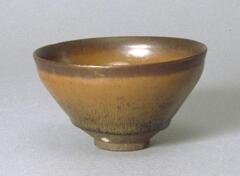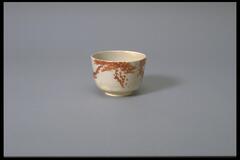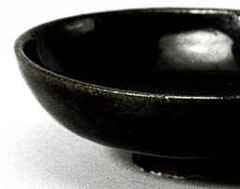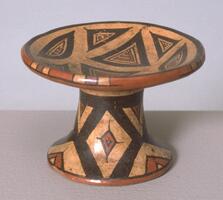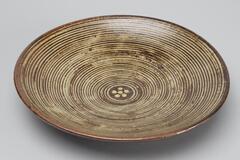11 Items in this Learning Collection
Collection Object
Collection Object
Collection Object
Collection Object
Collection Object
Collection Object
Collection Object
Collection Object
Copyright
All Rights Reserved
()
Teabowl
Accession Number
1964/2.77
Title
Teabowl
Artist(s)
Chinese
Artist Nationality
Chinese (culture or style)
Object Creation Date
12th century
Medium & Support
stoneware with glaze
Dimensions
2 3/16 in x 7 5/8 in x 7 5/8 in (5.56 cm x 19.37 cm x 19.37 cm);3 9/16 in x 9 5/8 in x 9 13/16 in (9.05 cm x 24.45 cm x 24.92 cm)
Credit Line
Museum purchase for the James Marshall Plumer Memorial Collection
Label copy
The Song dynasty (960–1279) in China was a period when the arts of painting, calligraphy, and ceramics reached extraordinary levels of refinement. One of the most celebrated ceramics of the day, produced under the direct supervision of the imperial court, was Ding ware, a creamy white stoneware made at the Ding kiln in northern China and known for its thin walls and elegantly drawn incised designs.
In the early twelfth century, the supremacy of white Ding ware was challenged when a new kind of tea came into favor. No less an authority than Emperor Huizong (r. 1101–25) declared that the black-glazed tea bowls from the Jian kilns of Fujian province in southern China were best for this new tea.
Very soon the Ding kiln began to make iron-glazed black bowl, such as this object, in attempt to compete with the southern Jian kilns. For examples of each type of ware see: white Ding ware (UMMA 1982/1.274), black Jian ware (UMMA 1964/2.8), and black Ding ware (this tea bowl).
No less an authority than Emperor Huizong (r. 1101–25), one of the greatest aesthetes in Chinese history, declared that the dark-glazed tea bowls from the Jian kilns of Fujian in south China were best for tea-drinking. Their thick bodies and black glaze retained heat and showed off the whipped froth of the beverage to advantage. The variegated iridescent glaze of Jian tea bowls was achieved through “controlled accidents” in the kiln and came to acquire aptly descriptive names like “oil spot,” “partridge-feather,” and most famous of all, “hare’s fur “.
Once black bowls became fashionable for tea in the early twelfth century, other kilns, even those best known for white wares, like the Ding kilns of north China, began to make bowls with dark glazes. The glazed surface of tautly-shaped and thinly-potted black Ding tea bowls was usually mat and plain, evoking the appearance of expensive black lacquer. The streaky russet- brown glaze applied over a previous glaze of shiny green-black on this Ding tea bowl is perhaps an attempt to outdo the sought-after “hare’s fur” glaze of Jian bowls.
(Label for UMMA Chinese Gallery Opening Rotation, March 2009)
Subject matter
A rare black ding ware tea bowl with a partridge feather mottle (鷓鴣斑 zhegu ban) for elaborate tea drinking events among scholars and elite of the Northern Song (960-1127) to Southern Song dynasties (1127-1279).
The Song dynasty (960–1279) in China was a period when the arts of painting, calligraphy, and ceramics reached extraordinary levels of refinement. One of the most celebrated ceramics of the day, produced under the direct supervision of the imperial court, was Ding ware, a creamy white stoneware made at the Ding kiln in northern China and known for its thin walls and elegantly drawn incised designs.
In the early twelfth century, the supremacy of white Ding ware was challenged when a new kind of tea came into favor. No less an authority than Emperor Huizong (r. 1101–25), one of the greatest aesthetes in Chinese history, declared that the black-glazed tea bowls from the Jian kilns of Fujian province in southern China were best for this new tea. Very soon the Ding kiln began to make iron-glazed black bowls, such as this object, in attempt to compete with the southern Jian kilns. For examples of each type of ware see: white Ding ware (UMMA 1982/1.274), black Jian ware (UMMA 1964/2.8), and black Ding ware (this tea bowl).
Emperor Huizong declared that the dark-glazed tea bowls from the Jian kilns of Fujian in south China were best for tea-drinking. Their thick bodies and black glaze retained heat and showed off the whipped froth of the beverage to advantage. The variegated, iridescent glaze of Jian tea bowls was achieved through “controlled accidents” in the kiln and came to acquire aptly descriptive names like “oil spot,” “partridge-feather,” and most famous of all, “hare’s fur “.
Once black bowls became fashionable for tea in the early twelfth century, other kilns, even those best known for white wares, like the Ding kilns of north China, began to make bowls with dark glazes. The glazed surface of tautly-shaped and thinly-potted black Ding tea bowls was usually mat and plain, evoking the appearance of expensive black lacquer. The streaky russet-brown glaze applied over a previous glaze of shiny green-black on this Ding tea bowl is perhaps an attempt to outdo the sought-after “hare’s fur” glaze of Jian bowls.
Physical Description
A conical, wide-flaring buff stoneware teabowl with a direct rim on a straight footring, covered with black glaze with russet brown mottling on the exterior and russet streaks on the interior.
Primary Object Classification
Ceramic
Primary Object Type
tea bowl
Additional Object Classification(s)
Ceramic
Collection Area
Asian
Rights
If you are interested in using an image for a publication, please visit http://umma.umich.edu/request-image for more information and to fill out the online Image Rights and Reproductions Request Form. Keywords
Ding (Chinese ceramics style)
bowls (vessels)
ceramic (material)
chawan
stoneware (pottery)
tea (beverage)
tea bowls
temmoku
1964/2.77
Title
Teabowl
Artist(s)
Chinese
Artist Nationality
Chinese (culture or style)
Object Creation Date
12th century
Medium & Support
stoneware with glaze
Dimensions
2 3/16 in x 7 5/8 in x 7 5/8 in (5.56 cm x 19.37 cm x 19.37 cm);3 9/16 in x 9 5/8 in x 9 13/16 in (9.05 cm x 24.45 cm x 24.92 cm)
Credit Line
Museum purchase for the James Marshall Plumer Memorial Collection
Label copy
The Song dynasty (960–1279) in China was a period when the arts of painting, calligraphy, and ceramics reached extraordinary levels of refinement. One of the most celebrated ceramics of the day, produced under the direct supervision of the imperial court, was Ding ware, a creamy white stoneware made at the Ding kiln in northern China and known for its thin walls and elegantly drawn incised designs.
In the early twelfth century, the supremacy of white Ding ware was challenged when a new kind of tea came into favor. No less an authority than Emperor Huizong (r. 1101–25) declared that the black-glazed tea bowls from the Jian kilns of Fujian province in southern China were best for this new tea.
Very soon the Ding kiln began to make iron-glazed black bowl, such as this object, in attempt to compete with the southern Jian kilns. For examples of each type of ware see: white Ding ware (UMMA 1982/1.274), black Jian ware (UMMA 1964/2.8), and black Ding ware (this tea bowl).
No less an authority than Emperor Huizong (r. 1101–25), one of the greatest aesthetes in Chinese history, declared that the dark-glazed tea bowls from the Jian kilns of Fujian in south China were best for tea-drinking. Their thick bodies and black glaze retained heat and showed off the whipped froth of the beverage to advantage. The variegated iridescent glaze of Jian tea bowls was achieved through “controlled accidents” in the kiln and came to acquire aptly descriptive names like “oil spot,” “partridge-feather,” and most famous of all, “hare’s fur “.
Once black bowls became fashionable for tea in the early twelfth century, other kilns, even those best known for white wares, like the Ding kilns of north China, began to make bowls with dark glazes. The glazed surface of tautly-shaped and thinly-potted black Ding tea bowls was usually mat and plain, evoking the appearance of expensive black lacquer. The streaky russet- brown glaze applied over a previous glaze of shiny green-black on this Ding tea bowl is perhaps an attempt to outdo the sought-after “hare’s fur” glaze of Jian bowls.
(Label for UMMA Chinese Gallery Opening Rotation, March 2009)
Subject matter
A rare black ding ware tea bowl with a partridge feather mottle (鷓鴣斑 zhegu ban) for elaborate tea drinking events among scholars and elite of the Northern Song (960-1127) to Southern Song dynasties (1127-1279).
The Song dynasty (960–1279) in China was a period when the arts of painting, calligraphy, and ceramics reached extraordinary levels of refinement. One of the most celebrated ceramics of the day, produced under the direct supervision of the imperial court, was Ding ware, a creamy white stoneware made at the Ding kiln in northern China and known for its thin walls and elegantly drawn incised designs.
In the early twelfth century, the supremacy of white Ding ware was challenged when a new kind of tea came into favor. No less an authority than Emperor Huizong (r. 1101–25), one of the greatest aesthetes in Chinese history, declared that the black-glazed tea bowls from the Jian kilns of Fujian province in southern China were best for this new tea. Very soon the Ding kiln began to make iron-glazed black bowls, such as this object, in attempt to compete with the southern Jian kilns. For examples of each type of ware see: white Ding ware (UMMA 1982/1.274), black Jian ware (UMMA 1964/2.8), and black Ding ware (this tea bowl).
Emperor Huizong declared that the dark-glazed tea bowls from the Jian kilns of Fujian in south China were best for tea-drinking. Their thick bodies and black glaze retained heat and showed off the whipped froth of the beverage to advantage. The variegated, iridescent glaze of Jian tea bowls was achieved through “controlled accidents” in the kiln and came to acquire aptly descriptive names like “oil spot,” “partridge-feather,” and most famous of all, “hare’s fur “.
Once black bowls became fashionable for tea in the early twelfth century, other kilns, even those best known for white wares, like the Ding kilns of north China, began to make bowls with dark glazes. The glazed surface of tautly-shaped and thinly-potted black Ding tea bowls was usually mat and plain, evoking the appearance of expensive black lacquer. The streaky russet-brown glaze applied over a previous glaze of shiny green-black on this Ding tea bowl is perhaps an attempt to outdo the sought-after “hare’s fur” glaze of Jian bowls.
Physical Description
A conical, wide-flaring buff stoneware teabowl with a direct rim on a straight footring, covered with black glaze with russet brown mottling on the exterior and russet streaks on the interior.
Primary Object Classification
Ceramic
Primary Object Type
tea bowl
Additional Object Classification(s)
Ceramic
Collection Area
Asian
Rights
If you are interested in using an image for a publication, please visit http://umma.umich.edu/request-image for more information and to fill out the online Image Rights and Reproductions Request Form. Keywords
Ding (Chinese ceramics style)
bowls (vessels)
ceramic (material)
chawan
stoneware (pottery)
tea (beverage)
tea bowls
temmoku
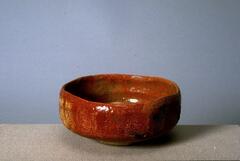

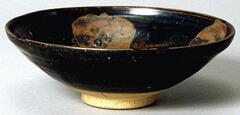
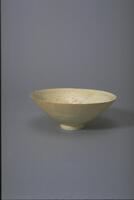
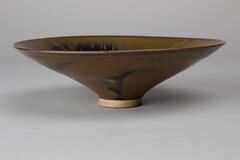
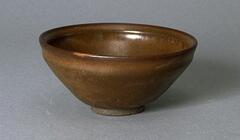

![It has a flared mouth. The side is tapering gently down to the base. It was brushed with white slip interior and outerior sides.<br />
<br />
Bowls of this kind were commonly used as burial accessories in the 15th century Joseon; many have been excavated. This bowl has been rapidly spun and brush-painted with white slip on its inner and outer surfaces. The large amount of sand mixed with the clay has produced a rough texture. Traces of clay supports remain on both the inner base and the rim of foot, indicating that this bowl was stacked among other bowls while separated by clay spurs during firing. The glaze was fused well, producing a glossy surface.<br />
[Korean Collection, University of Michigan Museum of Art (2014) p.155] It has a flared mouth. The side is tapering gently down to the base. It was brushed with white slip interior and outerior sides.<br />
<br />
Bowls of this kind were commonly used as burial accessories in the 15th century Joseon; many have been excavated. This bowl has been rapidly spun and brush-painted with white slip on its inner and outer surfaces. The large amount of sand mixed with the clay has produced a rough texture. Traces of clay supports remain on both the inner base and the rim of foot, indicating that this bowl was stacked among other bowls while separated by clay spurs during firing. The glaze was fused well, producing a glossy surface.<br />
[Korean Collection, University of Michigan Museum of Art (2014) p.155]](/media/W1siZiIsIjIwMjIvMDUvMjUvN2wwZnA4dXE4NV9kZWZhdWx0LmpwZyJdLFsicCIsInRodW1iIiwiMjQweDIwMCJdXQ?sha=8feb467e9a78db04)
![It has large-mouth and the wall slants toward the bottom in an almost straight line. It was deformed during firing.<br />
<br />
The inner and outer surfaces of this bowl are brushed with white slip. Traces of refractory spurs remain in five places on the inner base and the foot. The foot is glazed on the rim as well. This is a low-grade object with many iron-brown spots on both its inner and outer surfaces. A note from collector is adhered to the reverse side of the bowl, and it reads, “19629, corée, Hakéme,” “朝鮮刷毛目, 三百年.”<br />
[Korean Collection, University of Michigan Museum of Art (2014) p.156] It has large-mouth and the wall slants toward the bottom in an almost straight line. It was deformed during firing.<br />
<br />
The inner and outer surfaces of this bowl are brushed with white slip. Traces of refractory spurs remain in five places on the inner base and the foot. The foot is glazed on the rim as well. This is a low-grade object with many iron-brown spots on both its inner and outer surfaces. A note from collector is adhered to the reverse side of the bowl, and it reads, “19629, corée, Hakéme,” “朝鮮刷毛目, 三百年.”<br />
[Korean Collection, University of Michigan Museum of Art (2014) p.156]](/media/W1siZiIsIjIwMjIvMDUvMjUvOGwxcWg2N25pdF9kZWZhdWx0LmpwZyJdLFsicCIsInRodW1iIiwiMjQweDIwMCJdXQ?sha=35d40b809bdc1c1f)
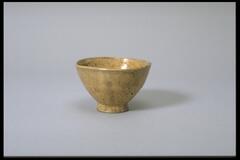
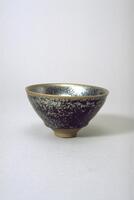
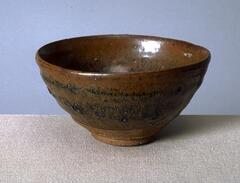
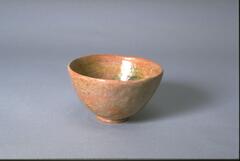
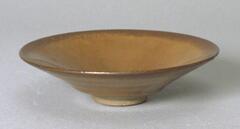
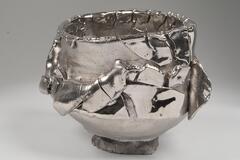
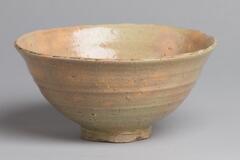
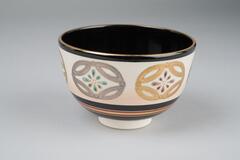
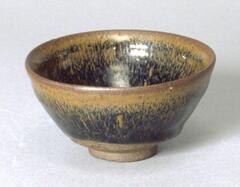
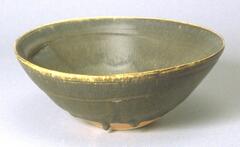

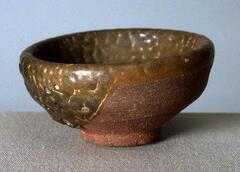
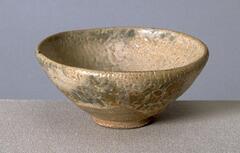
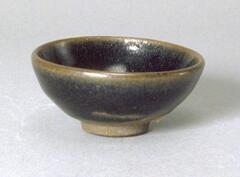
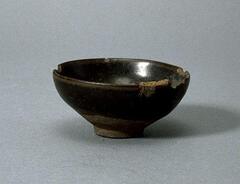
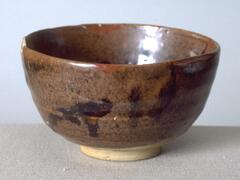
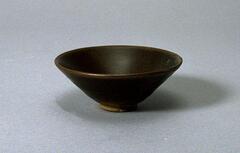
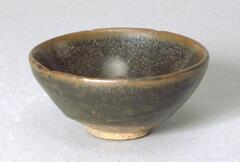

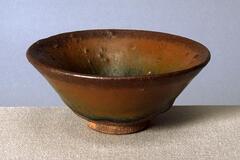
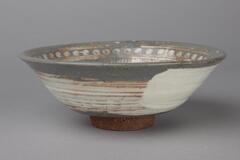
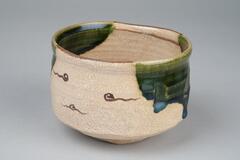
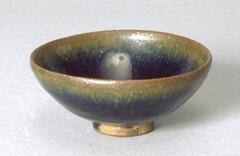


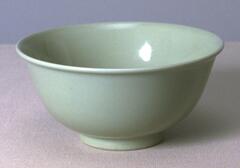

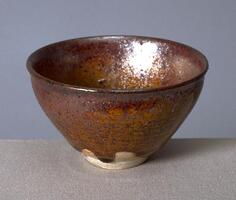
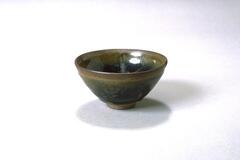

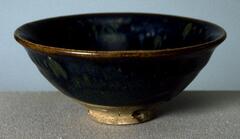
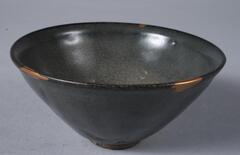
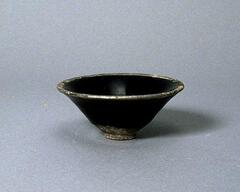
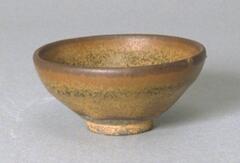
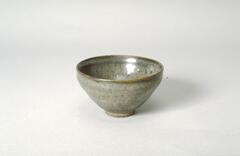

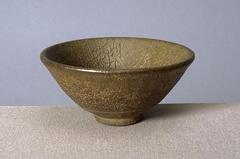
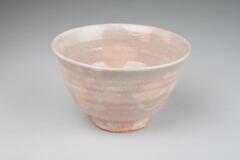
![Stoneware bowl with stamped rope-curtain design covered by a white slip and colorless glaze. A stylized inlaid chrysanthemum blossom decorates the center of the bowl, surrounded by a band of petals.<br />
<br />
This buncheong bowl with stamped design was maily supplied to government offices in the 15th century. It is decorated with a lotus flower on the inner base surrounded by lotus petals, butterflies and rows of dots on the inner wall. The outer wall, too, is filled with rows of dots. It was poorly sintered and the glaze applied to the lower part of the body is not melted in parts. The foot is not glazed and exposes the clay body.<br />
[Korean Collection, University of Michigan Museum of Art (2014) p.147] Stoneware bowl with stamped rope-curtain design covered by a white slip and colorless glaze. A stylized inlaid chrysanthemum blossom decorates the center of the bowl, surrounded by a band of petals.<br />
<br />
This buncheong bowl with stamped design was maily supplied to government offices in the 15th century. It is decorated with a lotus flower on the inner base surrounded by lotus petals, butterflies and rows of dots on the inner wall. The outer wall, too, is filled with rows of dots. It was poorly sintered and the glaze applied to the lower part of the body is not melted in parts. The foot is not glazed and exposes the clay body.<br />
[Korean Collection, University of Michigan Museum of Art (2014) p.147]](/media/W1siZiIsIjIwMjIvMDkvMjQvOWRtNDIyZTcyX2RlZmF1bHQuanBnIl0sWyJwIiwidGh1bWIiLCIyNDB4MjAwIl1d?sha=0b90e10dcc5f13d1)

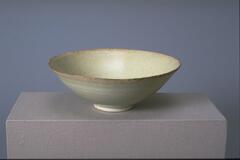
![<p>This is an undecorated bowl with diagonally flaring out sides. On the outer base and rim of the foot remain traces of refractory spur marks. The bowl was oxidized in the kiln, producing a green-brown hue, while the interior contains large bubbles. The color of its glaze is similar to that of other vessels excavated from sedimentary layers of refuse pile at celadon kilns in Goyang-si, Gyeonggi-do.<br />
[<em>Korean Collection, University of Michigan Museum of Art </em>(2014) p.101]</p>
<br />
It has an outwardly flared rim and steep side. A yellow brownish glaze is applied. The clay contains some impurities and the foot is relatively high. There is four spur-marks on the interior. <p>This is an undecorated bowl with diagonally flaring out sides. On the outer base and rim of the foot remain traces of refractory spur marks. The bowl was oxidized in the kiln, producing a green-brown hue, while the interior contains large bubbles. The color of its glaze is similar to that of other vessels excavated from sedimentary layers of refuse pile at celadon kilns in Goyang-si, Gyeonggi-do.<br />
[<em>Korean Collection, University of Michigan Museum of Art </em>(2014) p.101]</p>
<br />
It has an outwardly flared rim and steep side. A yellow brownish glaze is applied. The clay contains some impurities and the foot is relatively high. There is four spur-marks on the interior.](/media/W1siZiIsIjIwMjIvMDUvMjUvMnhtbDducjBocl9kZWZhdWx0LmpwZyJdLFsicCIsInRodW1iIiwiMjQweDIwMCJdXQ?sha=ab0ce1dba1be4d21)
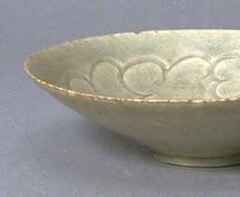
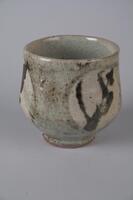
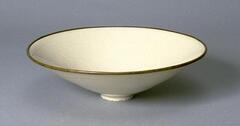
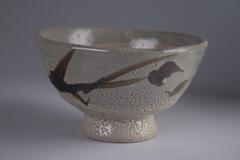
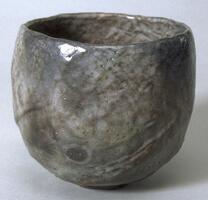
![Stoneware tea bowl with slightly flaring lip, white slip hakame design and colorless glaze.<br />
<br />
The inner and outer surfaces of this buncheong bowl have been brushed with white slip. Its inner base retains traces of seven spurs, while the uneven application of glaze has exposed the unglazed body. The glaze itself was fairly well fused. The bowl is intact without damage.<br />
[Korean Collection, University of Michigan Museum of Art (2014) p.156] Stoneware tea bowl with slightly flaring lip, white slip hakame design and colorless glaze.<br />
<br />
The inner and outer surfaces of this buncheong bowl have been brushed with white slip. Its inner base retains traces of seven spurs, while the uneven application of glaze has exposed the unglazed body. The glaze itself was fairly well fused. The bowl is intact without damage.<br />
[Korean Collection, University of Michigan Museum of Art (2014) p.156]](/media/W1siZiIsIjIwMjIvMDkvMjQvNm9xY20waHdlX2RlZmF1bHQuanBnIl0sWyJwIiwidGh1bWIiLCIyNDB4MjAwIl1d?sha=36b91ee5facf512c)
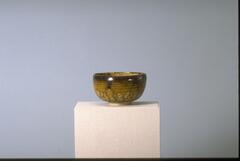
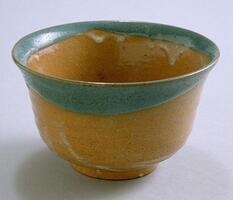




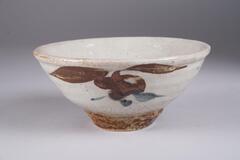
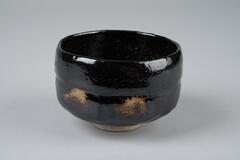
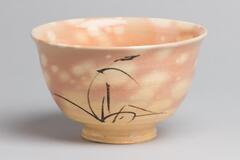

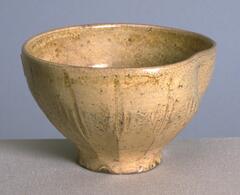
![<p>This bowl exemplifies early-tenth century celadon forms influenced by Chinese Yue ware. It has a halo-shaped foot (haemurigup), a characteristic of Yue ware. It is a high-quality celadon made from fine clay, coated by highly transparent glaze. Surface is plain while displaying crackles on its inner surface and parts of its outer surface. Many similar vessels were excavated from the Kilns no. 9 and no. 10 at Yongun-ri, Gangjin-gun, Jeollanam-do. Refractory spur marks created during firing remain in five places on the rim of the foot.<br />
[<i>Korean Collection, University of Michigan Museum of Art </i>(2014) p.88]</p>
Stoneware tea bowl with celadon glaze. <p>This bowl exemplifies early-tenth century celadon forms influenced by Chinese Yue ware. It has a halo-shaped foot (haemurigup), a characteristic of Yue ware. It is a high-quality celadon made from fine clay, coated by highly transparent glaze. Surface is plain while displaying crackles on its inner surface and parts of its outer surface. Many similar vessels were excavated from the Kilns no. 9 and no. 10 at Yongun-ri, Gangjin-gun, Jeollanam-do. Refractory spur marks created during firing remain in five places on the rim of the foot.<br />
[<i>Korean Collection, University of Michigan Museum of Art </i>(2014) p.88]</p>
Stoneware tea bowl with celadon glaze.](/media/W1siZiIsIjIwMjIvMDkvMjQvMXB2aXlzcnZpZF9kZWZhdWx0LmpwZyJdLFsicCIsInRodW1iIiwiMjQweDIwMCJdXQ?sha=7ddc9c1585910d07)

